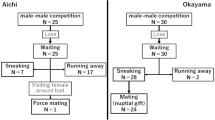Abstract
Mating behavior and factors affecting mating success of males were studied using wild Anastrepha ludens on a fieldcaged host tree. The most common courtship sequence had five components: (1) male calls from the underside of a leaf, (2) female arrives to the maleoccupied leaf, (3) male orients to female and stops calling, (4) one or both approach to a face-to-face position 1–3 cm apart, and (5) male mounts female after 1–2 s. Courtship behavior was almost identical to that of laboratoryculture flies observed previously under laboratory conditions. Most malefemale encounters occurred at a height of 1–2m, well inside the outer canopy of the tree. Differential mating success by males occurred. No male mated more than once per day, owing possibly to a very short sexual activity period. Factors favoring mating success of males were survival ability and tendency to join male aggregations and to fight other males. Thorax length and age (9–11 days difference) had no effects on male copulatory success. Overall win/loss percentage was not related to mating success because the males that were most successful at mating fought mostly among themselves, driving their win/loss percentage down. However, these successful males (at mating) won most of their fights against less successful males. Results confirmed a lek mating system: males aggregated, called, and defended territories; territories did not contain femalerequired resources; and females exercised mate choice, apparently through selection of sites within leks.
Similar content being viewed by others
References
Aluja, M., Hendrichs, J., and Cabrera, M. (1983). Behavior and interactions betweenAnastrepha ludens (L)(sic) andA. obliqua (M) (sic) on a field caged mango tree—Lekking behavior and male territoriality. In Cavallero, R. (ed.),Fruit Flies of Economic Importance, Proc. CECI IOBC Int. Symp., A. A. Balkema, Rotterdam, 1982, pp. 122–133.
Arita, L. H., and Kaneshiro, K. Y. (1985). The dynamics of the lek system and mating success in males of the Mediterranean fruit fly,Ceratitis capitata (Wiedemann).Proc. Hawaii. Entomol. Soc. 25: 39–48.
Arita, L. H., and Kaneshiro, K. Y. (1988). Body size and differential mating success between males of two populations of the Mediterranean fruit fly.Pac. Sci. 42: 173–177.
Burk, T. (1981). Signaling and sex in acalyptrate flies.Fla. Entomol. 64: 30–43.
Burk, T., and Calkins, C. O. (1983). Medfly mating behavior and control strategies.Fla. Entomol. 66: 3–18.
Burk, T., and Webb, J. C. (1983). Effect of male size on calling propensity, song parameters, and mating success in Caribbean fruit flies,Anastrepha suspensa (Loew) (Diptera: Tephritidae).Ann. Entomol. Soc. Am. 76: 678–682.
Calkins, C. O. (1984). The importance of understanding fruit fly mating behavior in sterile male release programs (Diptera: Tephritidae).Fol. Entomol. Mex. 61: 205–213.
Calkins, C. O. (1989). Quality control. In Robinson, A. S., and Hooper, G. (eds.),Fruit Flies, Their Biology, Natural Enemies and Control, Vol. 3B, Elsevier, New York, pp. 153–165.
Churchill-Stanland, C., Stanland, R., Wong, T. T. Y., Tanaka, N., McInnis, D. O., and Dowell, R. V. (1986). Size as a factor in the mating propensity of Mediterranean fruit flies,Ceratitis capitata (Diptera: Tephritidae), in the laboratory.J. Econ. Entomol. 79: 614–619.
Dickens, J. C., Solis, E., and Hart, W. G. (1982). Sexual development and mating behavior of the Mexican fruit fly,Anastrepha ludens (Loew).Southwest. Entomol. 7: 9–15.
Dodson, G. (1987). Tephritid mating systems, with special reference to antler flies.Entomol. Soc. Queensland News Bull. 15: 59–62.
Hendrichs, J. P. (1986).Sexual Selection in Wild and Sterile Caribbean Fruit Flies, Anastrepha suspensa (Loew) (Diptera: Tephritidae), M.S. thesis, University of Florida, Gainesville.
Landolt, P. J., and Hendrichs, J. (1983). Reproductive behavior of the papaya fruit fly,Toxotrypana curvicauda Gerstaecker (Diptera: Tephritidae).Ann. Entomol. Soc. Am. 76: 413–417.
McPhail, M., and Bliss, C. I. (1933). Observations on the Mexican fruit fly and some related species in Cuernavaca, Mexico, in 1928 and 1929. U.S. Dept. Agr. Circ. No. 255.
Prokopy, R. J. (1980). Mating behavior of frugivorous Tephritidae in nature. In Koyama, J. (ed.),Fruit Fly Problems, Proc. Sym. Nat. Inst. Agr. Sci., 1980, Natl. Inst. Agr. Sci., Japan, pp. 37–46.
Robacker, D. C. (1988). Behavioral responses of female Mexican fruit flies,Anastrepha ludens, to components of male-produced sex pheromone.J. Chem. Ecol. 14: 1715–1726.
Robacker, D. C., and Hart, W. G. (1985). Courtship and territoriality of laboratory-reared Mexican fruit flies,Anastrepha ludens (Diptera: Tephritidae), in cages containing host and nonhost trees.Ann. Entomol. Soc. Am. 78: 488–494.
Robacker, D. C., Ingle, S. J., and Hart, W. G. (1985). Mating frequency and response to maleproduced pheromone by virgin and mated females of the Mexican fruit fly.Southwest. Entomol. 10: 215–221.
Rubink, W. L. (1988). A photographic technique for producing high-quality insect tags for mark/ release/recapture studies.Entomol. News 99: 167–171.
Sivinski, J., and Smittle, B. (1987). Male transfer of materials to mates in the Caribbean fruit fly,Anastrepha suspensa (Diptera: Tephritidae).Fla. Entomol. 70: 233–238.
Stone, A. (1942). The fruitflies of the genusAnastrepha. U.S. Dept. Agr. Misc. Publ. No. 439.
Author information
Authors and Affiliations
Rights and permissions
About this article
Cite this article
Robacker, D.C., Mangan, R.L., Moreno, D.S. et al. Mating behavior and male mating success in wildAnastrepha Ludens (Diptera: Tephritidae) on a field-caged host tree. J Insect Behav 4, 471–487 (1991). https://doi.org/10.1007/BF01049332
Accepted:
Issue Date:
DOI: https://doi.org/10.1007/BF01049332




